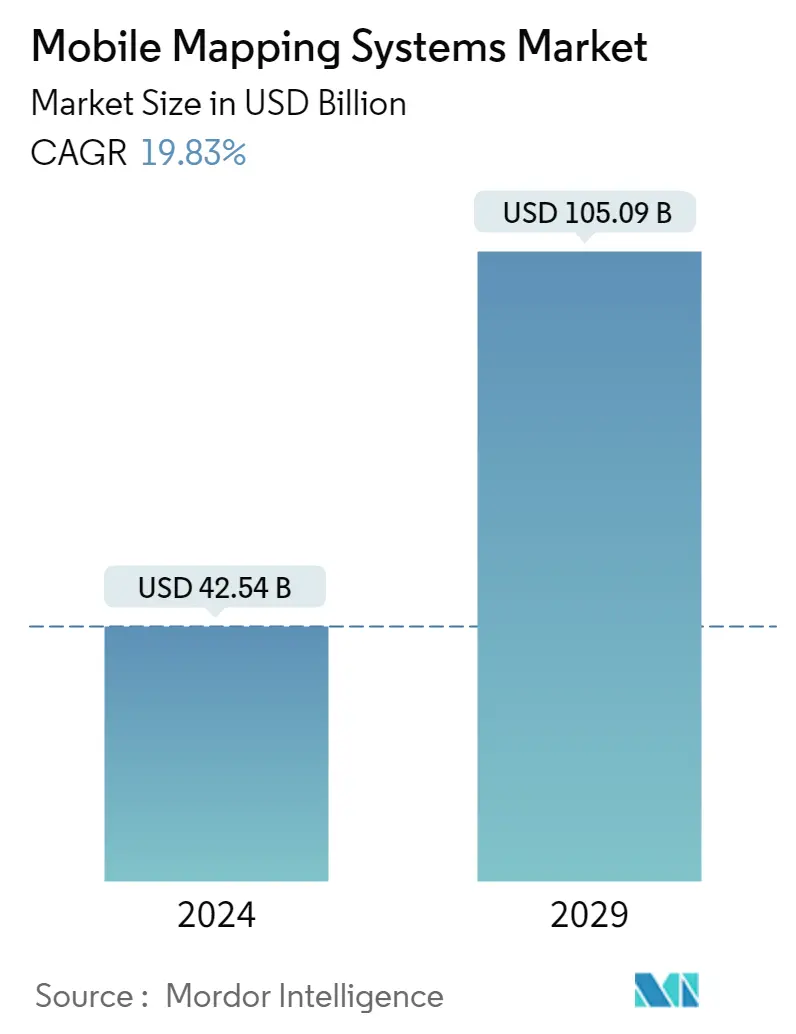Market Size of Mobile Mapping Systems Industry

| Study Period | 2019 - 2029 |
| Market Size (2024) | USD 42.54 Billion |
| Market Size (2029) | USD 105.09 Billion |
| CAGR (2024 - 2029) | 19.83 % |
| Fastest Growing Market | Asia-Pacific |
| Largest Market | North America |
Major Players
*Disclaimer: Major Players sorted in no particular order |
Mobile Mapping Systems Market Analysis
The Mobile Mapping Systems Market size is estimated at USD 42.54 billion in 2024, and is expected to reach USD 105.09 billion by 2029, growing at a CAGR of 19.83% during the forecast period (2024-2029).
The rapid acceptance of satellite mapping technology and its seamless integration into smartphones and Internet of Things (IoT)-connected devices are driving the market's growth.
Smart cities rapidly expanded due to increased urbanization and supported government initiatives worldwide. A smart city can only exist with a 3D map. With the support of 3D city modeling, autonomous navigation, traffic, disaster management, digitizing roadway property, and pollution reduction, mobile mapping technology for smart cities aims to improve quality of life by optimizing resources and maintaining sustainability. Smartphone and internet usage played critical roles in data management and access.
Further, mobile navigation geographic information system (GIS) for environmental monitoring is increasingly used in monitoring the environment. Environmental researchers are employing mobile mapping GIS tools to help with storm and hurricane forecasting and monitoring. The NASA-funded research project on ecological monitoring and natural resource management drives revenue growth in the mobile mapping sector.
Mobile mapping systems are used for various applications, including developing indoor maps for pedestrian navigation, high-definition (HD) maps for autonomous vehicles, asset and infrastructure management, ariel surveys, pipeline surveys, hydrographic surveys, dredging, and offshore positioning/drilling operations.
The emergence of on-demand deployment systems is an inflection point in the mobile mapping market, as high levels of flexibility and accuracy at low initial costs are offered (users are charged on a monthly/quarterly basis). Companies offer subscription-based models to counter the need for perpetual user licenses.
The COVID-19 pandemic resulted in a rapid restructuring of the IT industry, with firms shifting to remote labor. During the pandemic, the mobile mapping market grew considerably. Several businesses and agencies used mobile mapping data for visualization and geospatial analytics to restrict the spread of the disease. Dashboards were used to display geospatial data. Some of these dashboards and applications received data changes in near-real time.
Mobile Mapping Systems Industry Segmentation
Mobile mapping collects geospatial data from a mobile vehicle, typically fitted with GNSS, radar, laser, LiDAR, photographic, or other remote sensing systems. These systems are made up of an integrated array of time-synchronized navigation and imaging sensors mounted on a mobile platform. The output from these systems includes GIS data, digital maps, and georeferenced images and videos.
The study examines the development of new databases for diverse end users in the mobile mapping sector. A time-synchronized integrated array of navigation and imaging sensors installed on mobile platforms makes mobile mapping software systems successful for various purposes in the mobility world.
The market is segmented by applications (imaging services, aerial mobile mapping, emergency response planning, internet applications, facility management, satellite), end-user verticals (government, oil & gas, mining, military), and geography (North America, Europe, Asia-Pacific, Latin America, the Middle East, and Africa).
The market size and forecast are provided in terms of value (USD billion) for all the above segments.
| By Application | |
| Imaging Services | |
| Aerial Mobile Mapping | |
| Emergency Response Planning | |
| Internet Applications | |
| Facility Management | |
| Satellite |
| By End-user Verticals | |
| Government | |
| Oil and Gas | |
| Mining | |
| Military | |
| Other End-user Verticals |
| By Geography | |
| North America | |
| Europe | |
| Asia Pacific | |
| Latin America | |
| Middle East and Africa |
Mobile Mapping Systems Market Size Summary
The mobile mapping market is experiencing significant growth, driven by the increasing integration of satellite mapping technology into smartphones and IoT devices. This growth is further fueled by the expansion of smart cities, which rely on 3D mapping for various applications such as autonomous navigation, traffic management, and environmental monitoring. The technology is also being utilized in diverse fields, including indoor mapping, autonomous vehicle navigation, and infrastructure management. The emergence of on-demand deployment systems, offering flexibility and cost-effectiveness, is reshaping the market dynamics. The COVID-19 pandemic accelerated the adoption of mobile mapping for geospatial analytics, aiding in disease spread containment. Additionally, satellite imagery and GIS systems are enhancing crime mapping and environmental monitoring efforts, addressing challenges like illegal fishing and resource management.
The Asia-Pacific region is poised for substantial growth, supported by government initiatives and infrastructure modernization projects. The region's market expansion is characterized by innovative solutions and strategic partnerships, such as those by Emesent and Grab Holdings Limited. The presence of major players like Google Inc., Trimble, and Topcon Corporation is intensifying competition, with significant investments in R&D to drive innovation. The market's competitive landscape is marked by high barriers to exit and firm concentration, contributing to moderately high competitive rivalry. Recent advancements include real-time traffic alerts and AI-driven mobile mapping systems, underscoring the industry's commitment to enhancing location-based services and infrastructure development.
Mobile Mapping Systems Market Size - Table of Contents
-
1. MARKET INSIGHTS
-
1.1 Market Overview
-
1.2 Industry Attractiveness - Porter's Five Forces Analysis
-
1.2.1 Bargaining Power of Suppliers
-
1.2.2 Bargaining Power of Consumers
-
1.2.3 Threat of New Entrants
-
1.2.4 Threat of Substitutes
-
1.2.5 Intensity of Competitive Rivalry
-
-
1.3 Assessment of the Impact of COVID-19 on the Industry
-
1.4 Industry Value Chain Analysis
-
-
2. MARKET SEGMENTATION
-
2.1 By Application
-
2.1.1 Imaging Services
-
2.1.2 Aerial Mobile Mapping
-
2.1.3 Emergency Response Planning
-
2.1.4 Internet Applications
-
2.1.5 Facility Management
-
2.1.6 Satellite
-
-
2.2 By End-user Verticals
-
2.2.1 Government
-
2.2.2 Oil and Gas
-
2.2.3 Mining
-
2.2.4 Military
-
2.2.5 Other End-user Verticals
-
-
2.3 By Geography
-
2.3.1 North America
-
2.3.2 Europe
-
2.3.3 Asia Pacific
-
2.3.4 Latin America
-
2.3.5 Middle East and Africa
-
-
Mobile Mapping Systems Market Size FAQs
How big is the Mobile Mapping Systems Market?
The Mobile Mapping Systems Market size is expected to reach USD 42.54 billion in 2024 and grow at a CAGR of 19.83% to reach USD 105.09 billion by 2029.
What is the current Mobile Mapping Systems Market size?
In 2024, the Mobile Mapping Systems Market size is expected to reach USD 42.54 billion.

